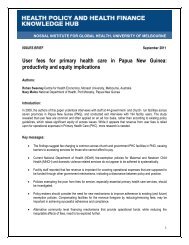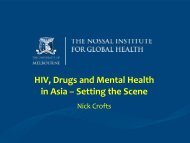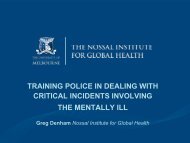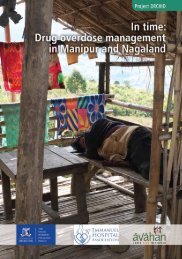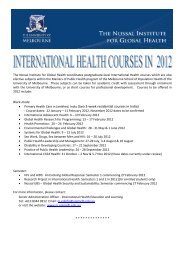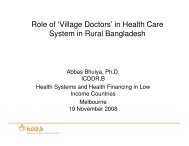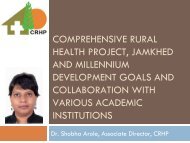AN INTRODUCTION TO MENTAL HEALTH - The Nossal Institute for ...
AN INTRODUCTION TO MENTAL HEALTH - The Nossal Institute for ...
AN INTRODUCTION TO MENTAL HEALTH - The Nossal Institute for ...
You also want an ePaper? Increase the reach of your titles
YUMPU automatically turns print PDFs into web optimized ePapers that Google loves.
Activity 4 : Symptoms of mental disorder<br />
Time : 1 hour<br />
Purpose : To help participants recognise symptoms associated with mental<br />
disorders.<br />
Materials : Paper and marker pens, black/white board and ‘Symptoms of mental<br />
disorders cards’ (found in Appendix C).<br />
NB : It will be necessary to label each of these cards with suitably translated<br />
words prior to commencement of the training session.<br />
Directions : Step 1<br />
Give a short presentation of the in<strong>for</strong>mation provided in the ‘In<strong>for</strong>mation<br />
<strong>for</strong> Presentation’ box below.<br />
INFORMATION FOR PRESENTATION<br />
<strong>The</strong> symptoms of mental disorders can produce a negative effect on the lives of individuals,<br />
families and society as a whole.<br />
You cannot always tell just by looking at a person whether or not they have a mental disorder.<br />
<strong>The</strong> symptoms of mental disorders can be physical or psychological.<br />
1. Physical symptoms are those that involve the physical functioning of the body e.g. aches<br />
and pains, weakness, tiredness, sleep disturbance, and increased or decreased appetite.<br />
2. Psychological symptoms are those that involve the mental functioning of the body.<br />
a. Feeling symptoms are those that involve our emotions or feelings e.g. sadness, fear<br />
and worry.<br />
b. Thinking symptoms are those that affect the way a person thinks e.g. problems in<br />
understanding, concentrating, memory, and judgment (decision-making). Thinking<br />
about ending your life (suicide) or thinking that someone else is going to harm you are<br />
examples of thinking symptoms.<br />
c. Behavioural symptoms are those that affect the way people act or what they do.<br />
Behaviours are what we actually see others doing e.g. being aggressive, increased or<br />
decreased talking, withdrawal from family and friends, self-harm e.g. cutting the skin,<br />
and attempting suicide.<br />
d. Imagining symptoms are those that involve the person perceiving or experiencing<br />
things that are not actually real (although they seem very real to the person experiencing<br />
them). For example, the person may be hearing voices or seeing things that are not<br />
actually present. 2,5<br />
Some of the symptoms associated with mental disorders, such as feelings of sadness and<br />
worrying a lot, affect everybody from time to time. <strong>The</strong>se symptoms only become a mental<br />
26<br />
<strong>AN</strong> <strong>INTRODUCTION</strong> <strong>TO</strong> <strong>MENTAL</strong> <strong>HEALTH</strong>






